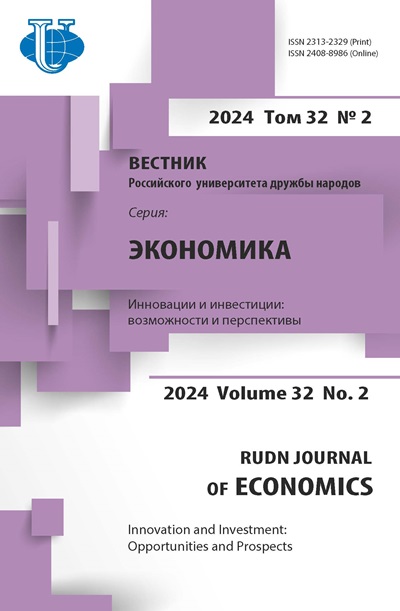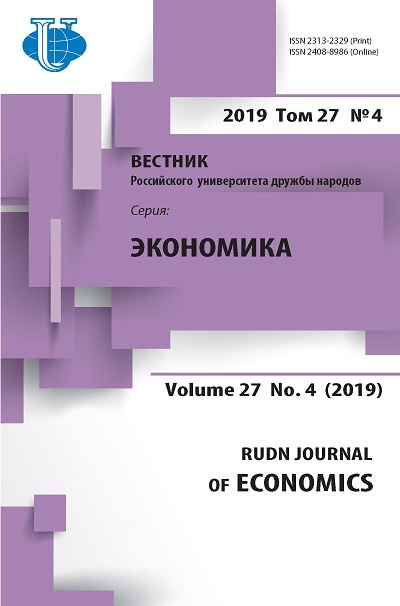Тенденции спроса на мировом рынке минеральных удобрений
- Авторы: Дюжева Н.В.1, Тинькова А.А.1
-
Учреждения:
- Российский университет дружбы народов
- Выпуск: Том 27, № 4 (2019)
- Страницы: 722-731
- Раздел: ГЛОБАЛИЗАЦИЯ И ЭКОНОМИЧЕСКАЯ ИНТЕГРАЦИЯ
- URL: https://journals.rudn.ru/economics/article/view/23409
- DOI: https://doi.org/10.22363/2313-2329-2019-27-4-722-731
Цитировать
Полный текст
Аннотация
В исследовании проводится анализ тенденций на мировом рынке минеральных удобрений. Цель - определить факторы, влияющие на потребление удобрений. В круг поставленных задач входят анализ динамики и структуры спроса, предложения, внешней торговли, неценовых факторов и характеристик и прогноз их развития; анализ взаимосвязей между потреблением удобрений, площадью посевных площадей, урожайностью зерновых; изучение феномена потребления минеральных удобрений в России. В статье даны ответы на вопросы, где сосредоточено потребление удобрений и почему именно там. Выявленными лидерами по производству на рынке являются Китай и Россия; мировые потребители - Бразилия, Индия, Китай и США. Страны с самым высоким урожаем зерновых в мире не совпадают с крупнейшими странами - потребителями удобрений. Урожайность зерновых и уровень внесения удобрений на гектар посевных площадей в крупнейших странах - потребителях минеральных удобрений напрямую не связаны. Страны с самой высокой урожайностью зерновых в основном хорошо развиты, но у них относительно небольшие посевные площади. У большинства из них почва не подходит для сельского хозяйства. Когда посевная площадь (га) увеличивается на 1 %, потребление удобрений увеличивается на 0,7 % с вероятностью 99 %. По этой модели Россия недостаточно потребляет на 10 569 т от расчетного объема. Данные были классифицированы в программе Exсel и проанализированы с помощью программного обеспечения эконометрического моделирования Eviews.
Ключевые слова
Об авторах
Наталья Валериевна Дюжева
Российский университет дружбы народов
Автор, ответственный за переписку.
Email: dioujeva@yandex.ru
кандидат экономических наук, доцент кафедры международных экономических отношений
Российская Федерация, 117198, Москва, ул. Миклухо-Маклая, 6Арина Александровна Тинькова
Российский университет дружбы народов
Email: tinkova_aa@pfur.ru
магистрант экономики, кафедра международных экономических отношений
Российская Федерация, 117198, Москва, ул. Миклухо-Маклая, 6Список литературы
- Batakova, V.M., Dmitrieva, G.S., & Semykina, G.V. (1973). Khimizatsiya sel'skogo khozyaistva [Сhemicalization of agriculture]. Moscow: Nauch.-issled. in-t tekhn.-ekon. issledovanii NIITEKhIM. (In Russ.)
- Bleiman, N., & Burkov, A. (2017). Plan mineral'nogo nastupleniya [Mineral attack plan]. RBC+, 181(2678), 1-4. (In Russ.)
- Falina, N.V., & Dyukarev, D.O. (2016). Mirovoi rynok mineral'nykh udobrenii [The global market for mineral fertilizers]. Economics, 1(10), 83-86. (In Russ.)
- Food and agriculture organization of the UN. (2017). World fertilizer trends and outlook to 2020. FAO, Rome, Italy, 2-4.
- International fertilizer association. (2019). Outlook summary reports. Montreal. Retrieved from https://www.ifastat.org/market-outlooks (accessed: 09.07.2019).
- Lyskova, I.V., Lyskova, T.V., & Mazurova, S.V. (2018). Influence of mineral fertilizers on productivity and grain quality in spring wheat Iren. Zernobobovye i krupyanye kul'tury, 4(28), 141-147. doi: 10.24411/2309-348X-2018-11064. (In Russ.)
- Nazarbek, U.B. (2013). Analiz sostoyaniya mirovogo rynka mineral'nyh udobrenij [Analysis of the state of the global market of mineral fertilizers] Aktual'nye problemy gumanitarnyh i estestvennyh nauk, (2-1), 7-12. (In Russ.)
- Rodionova, I.A. (2010). Mirovaya ekonomika industrial'nyj sector [World Economy Industrial Sector]: study guide (pp. 482-494). Moscow: RUDN University. (In Russ.)
- Semina, Yu.A. (2016). Sostoyanie rynka ammiachnoj selitry v Rossii v period 2015-2016 gg. [The state of the market of ammonium nitrate in Russia in the period 2015-2016]. Vestnik himicheskoj promyshlennosti NIITEKHIM. Retrieved from http://vestkhimprom.ru/ (In Russ.)
- Volkova, A.V. (2015). Rynok mineral'nykh udobrenii [Mineral fertilizer market]. Moscow: Natsional'nyi issledovatel'skii universitet “Vysshaya shkola ekonomiki”. Retrieved from https://dcenter.hse.ru/data/2015/12/22/1132768850/IV%20кв%202015.pdf (In Russ.)
- Yakovleva, A. (2017). Mirovoi rynok mineral'nykh udobrenii [World mineral fertilizer market]. AgroSnabForum, (3), 54-57. (In Russ.)















